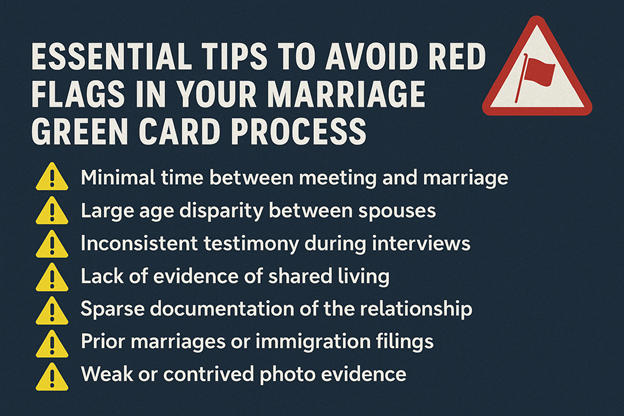
Why USCIS marriage interview Red Flags Matter in Marriage-Based Green Card Applications
Navigating a USCIS marriage interview can be daunting, and understanding the common red flags is crucial for a successful outcome. One of the most significant warning signs for USCIS is inconsistent answers during the interview. Officers ask detailed questions about the couple’s life. While most marriages are legitimate, the potential for fraud means USCIS officers scrutinize every detail. Inconsistencies, unusual patterns, or missing information could delay your application or even lead to a denial. Knowing what these red flags are—and how to address them—can make all the difference in successfully obtaining your green card. In this article, we dive into the top red flags you need to watch out for when filing Form I-485.
Minimal Time Between Meeting and Marriage is an important aspect in USCIS marriage interview red flags
A quick courtship before marriage can raise red flags with USCIS, as short timelines are often associated with fraudulent marriages. While rapid marriages can be genuine, they require careful documentation to prove authenticity. USCIS officers will likely ask for a detailed relationship timeline and supporting evidence, such as communication records, photos, and travel history. If your marriage happened quickly, it’s essential to provide a strong, consistent narrative and ample proof to demonstrate the legitimacy of your union.
Large Age Disparity Between Spouses
A significant age gap, especially when paired with differences in culture or socioeconomic status, can raise concerns for USCIS. While age differences are not automatically problematic, they may prompt further scrutiny of the relationship. Couples in this situation should focus on demonstrating emotional closeness, integration of lives, and family support. Providing evidence such as shared finances, holidays together, and joint goals can help establish the authenticity of the marriage.
Inconsistent Testimony During Interviews
One of the most significant red flags for USCIS is inconsistent answers during the marriage interview. Officers ask detailed questions about the couple’s life, including routines, family dynamics, and even personal habits. Conflicting or vague responses can raise suspicion. To avoid this, couples should prepare together by discussing the facts of their relationship honestly. While it’s important to be prepared, authenticity is crucial—over-rehearsing can make answers seem unnatural. Focus on providing consistent and coherent responses to demonstrate the legitimacy of your marriage.
Lack of Evidence of Shared Living is also and important aspect in USCIS marriage interview red flags
Living together is a strong indicator of a genuine marriage. Absence of joint lease agreements, utility bills, or shared mail can raise doubts. If living separately is unavoidable (due to work or other reasons), provide a clear explanation along with supporting evidence, such as frequent visits or shared financial accounts.
Sparse Documentation of the Relationship
USCIS expects robust documentation of your relationship, including joint bank accounts, tax returns, photos, and texts. Lack of evidence or poorly organized material can raise suspicions. Be proactive in collecting dated, credible documentation and consider including affidavits from friends and family.
Prior Marriages or Immigration Filings
A history of prior marriages, especially with foreign nationals, may raise questions. If the U.S. citizen has sponsored others or the immigrant spouse has previous immigration attempts, address these openly. Provide divorce records, immigration history, and a clear explanation to demonstrate the legitimacy of the current relationship.
Language and Cultural Barriers
Language or cultural differences in an intercultural marriage may trigger questions. Be ready to explain how you communicate and maintain emotional intimacy, and provide translated messages, video chats, and proof of mutual travel. Showing that both families support the relationship strengthens your case.
Disparities in Financial Status or Employment
A significant difference in income, education, or employment can raise suspicions of a transactional marriage. Provide honest financial documentation, such as tax returns, employment letters, and an affidavit of support, ensuring you meet USCIS’s financial requirements.
Weak or Contrived Photo Evidence
Photos should reflect a natural relationship progression. Posed or identical photos can seem staged. Include a variety of candid moments, holidays, and family photos to show the authenticity of your bond. Ensure your photo evidence appears genuine and consistent over time.





